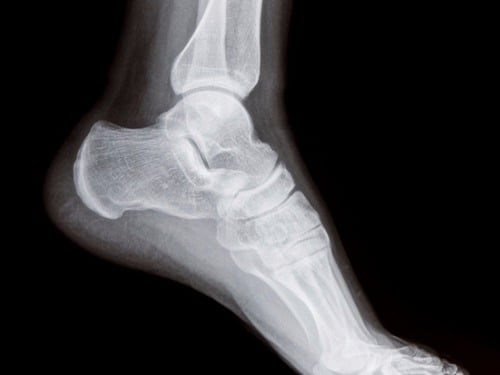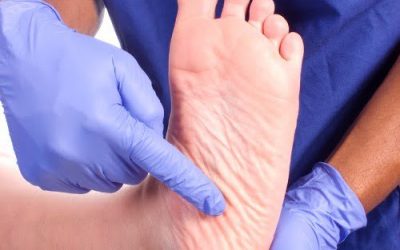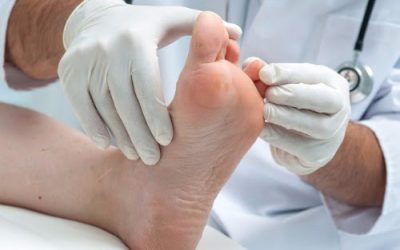Those affected by Charcot-Marie-Tooth disease often display distinct physical symptoms that manifest in their feet. A basic overview of CMT foot symptoms that can be found below.
High Arches and Clawfoot:
The classic, very high arch is formed because the peroneal group no longer properly opposes the tibial muscles. Muscles need to be balanced. The tibial muscles get “free reign” and work without an opposing balance. This results in a pulled up arch, tipping the foot outwards, which creates instability, tiredness, and can lead to ankle sprains.
Motor weakness is the hallmark of CMT and is the cause for clawfeet. The ankle dorsiflexors, the muscles that lift up the foot and ankle, are frequently involved. When the Tibialis Anterior muscle weakens, the foot begins to drop down. This is usually a gradual process, occurring over months or years.
Treatment for Clawfoot
It is very important to keep the Achilles tendon in the calf stretched out. Keeping the Achilles limber can keep a person walking normally for a long time. Stretch the tendon for 60 seconds 3 times each day. There are several stretching programs available, but the easiest and best is to place the front of the foot on a step and let the heel hang over the edge (hold on to the railing to keep your balance).
In more advanced cases, a brace may be required. There are several types available, which are generically called Ankle Foot Orthoses (AFOs). An Orthotist or certified Pedorthist are the professionals who fabricate such braces.
Deformity of the Toes
Deformity of the toes occurs frequently in people that have CMT. An imbalance of muscle pull on the toes causes them to deform. The term “clawing” is used because each toe develops a fixed flexion contracture in the shape of a claw. The contracted toes do not have enough room in shoes and put increased pressure on the ball of the foot, which becomes painful and callused.
Treatment for Deformity of the Toes
While there is nothing one can do to prevent the muscle imbalance, the contractures can be avoided, or at least delayed. Twice a day, once in the morning and once before bedtime, stretch each of the toe joints. Flex down the joint at the base of each toe (Metatarsalphalangeal joint) as far as possible while bringing the middle joint (Proximal Interphalangeal joint) to a straight position. Hold for thirty seconds and then go onto the next toe.
Once a contracture develops, make sure to wear shoes that have a wide toe box to minimize pressure on the toes. A shoe repair shop can stretch out your normal shoes or special wide toe-box shoes can be purchased. Your shoes should have a cushioned sole and be made of a soft, stretchable upper material. A custom orthotic can help relieve pressure on the ball of the foot.
Ingrown Toenails
The toenail is produced by its own special nail-generating tissue and grows forward to the end of the toe. In the case of the ingrown toenail, which tends to occur most often with the big toe, the nail groove begins to disappear. This can be the result of ill-fitting shoes, or from a deformed way of walking that places an unusual amount of pressure on this area of the foot.
The chronic pressure of the nail edge rubbing against the nail groove causes irritation and swelling of the surrounding skin. This constant pressure can eventually results with infection, leading to even more pain and swelling. Improper trimming of the toenail can also cause problems. If the corner of the toenail is not allowed to grow out past the skin at the end of the nail groove, it may dig into the skin. This makes pressure when walking even more painful.
Ingrown toenails are a common problem for people with CMT due to the pressure placed on the front and side of the foot while walking. When hand dexterity difficulties are an issue, this further exacerbates the problem as nail and foot care can be a challenging task to perform.
Treatment for Ingrown Toenails
Due to sensory loss association with CMT, especially in the foot, it is an important practice to take extra precautions with foot care. If necessary, seek professional assistance to ensure your toenails are regularly trimmed and monitored for ingrown toenails and other problems.
There are various surgical procedures to assist if the condition has been longstanding and resulted in permanent hypertrophy of the tissue surrounding the nail margin. A wedge resection procedure removes of a portion of the hypertrophied tissue and therefore reduces the pressure and irritation. In this procedure, a wedge of tissue is removed and the healing process allows the nail groove to reform itself a partial nail and matrix removal is done in more severe cases; this removes a portion of the toenail and the germinal matrix that produces that portion of the nail. For extreme deformity, a nail and matrix ablation is done to remove the entire nail and its germinal matrix. No new toenail will grow back and this is usually done only as last resort.
Fungal Toenails
According to Dr. Hal Ornstein on footdoctorsnj.com, many people do not realize they have a fungal nail problem and, therefore, do not seek treatment. Yet, fungal toenail infections are a common foot health problem and can persist for years without ever causing pain. The disease, characterized by a change in a toenail’s color, is often considered nothing more than a mere blemish. Left untreated, however, it can present serious problems.
You can prevent fungal nail infections by taking these simple precautions:
- Exercise proper hygiene and regularly inspect your feet and toes.
- Keep your feet clean and dry.
- Wear shower shoes in public facilities whenever possible.
- Clip nails straight across so that the nail does not extend beyond the tip of the toe.
- Use a quality foot powder (talcum, not cornstarch) in conjunction with shoes that fit well and are made of materials that breathe.
- Avoid wearing excessively tight hosiery, which promotes moisture. Socks made of synthetic fiber tend to “wick” away moisture faster than cotton or wool socks, especially for those with lifestyles that are more active.
- Disinfect home pedicure tools and don’t apply polish to nails suspected of infection.
- In severe cases, surgical treatment may be required to remove the infected nail. Permanent removal of a chronically painful nail, which has not responded to any other treatment, permits the fungal infection to be cured and prevents the return of a deformed nail.
Swollen Feet and Ankles
Dr. Greg Carter, one of our CMT advisors, says:
“People with CMT have swelling in their feet and ankles because they don’t have the normal muscle strength and activity in the legs that helps pump the venous blood and lymphatic fluids back towards the heart. This is common in many neuromuscular disorders. Breathing and/or heart problems can definitely cause swelling of the feet and ankles, and can be an early sign of heart failure. People with CMT have to be particularly careful because swollen feet and legs can lead to skin breakdown and ulcers. These ulcers may get infected and sometimes lead to loss of the foot or leg (i.e., if they get gangrene). CMT people are already prone to neuropathic ulcers so they are at very high risk.”
Treatment for Swollen Feet and Ankles
Dr. Carter suggests CMT patients should treat their feet just like diabetics do: daily inspection; gentle soak and cleansing; emollient creams to keep the skin supple; proper foot- wear and correctly fitted braces/orthotics (CMT people should always use custom-fitted braces/orthotics, not off-the-shelf models). TED hose are okay as long as they are taken off for part of the day and the skin thoroughly inspected. Further, CMT people should not smoke because this can lead to peripheral vascular disease (hardening/clogging of the arteries), which worsens the situation.
Calluses
Heel calluses, also called plantar calluses, develop when one metatarsal bone is longer or lower than the others and it hits the ground with more force than it is equipped to handle. As a result, the skin under this bone thickens. The resulting callus causes irritation and pain.
Treatment for Calluses
Because people with CMT often have an imbalanced gait, calluses easily can form. In most cases, heel calluses can be treated without surgery. In severe cases, however, a surgical procedure called an osteotomy is performed to relieve the pressure on the bone.
Restless Leg Syndrome
Restless Leg Syndrome is a sensory-motor disorder and is evidentially related to periodic limb movement disorder (PLMD). Similar to CMT there is often a family history of RLS. People describe the sensation in their legs in a variety of ways such as, tingling, pins and needles, creepy-crawling sensations, sudden jerky movements, and having an irresistible urge to move their legs. Movement temporarily helps to relief the discomfort. RLS becomes more apparent when individuals are at rest and can be very disruptive to the onset of sleep, which ultimately lessens the restfulness that we require from sleeping. It can be disturbing for partners of people who experience RLS as well.
Treatment for Restless Leg Syndrome
There are OTC and prescription medication for the treatment of symptoms. Some lifestyle changes also may alleviate symptoms.







My wife has cmt and we were taking care of a cut on her foot. I pulled her sock up and it snagged on a toe, ripping it off. There wasn’t much blood or pain but has anyone experienced that and did a toenail grow back or was the circulatory issue common in cmt making it difficult or impossible for one to grow back?
My cousin just told me that our family tree has CMT and it explains a lot of our family medical history. With loss of feeling in my left foot, clawing and extreme pain…I have no doubt. For five years I have suffered with chronic, random swelling of tendon sheaths in my arms, hands and legs. Any possible correlation?
Hi. In the last week, my wife and I have learned that my 17-year-old, extremely athletic son, likely has CMT. We have a neurologist appointment at a Center of Excellence soon, and we will likely begin the testing to determine which type of CMT. This will devastate my son, as he will do a web search and find that the outlook can be quite life-limiting, though there are also lots of inspirational stories about people having good quality of life. Currently, he is very functional, and is #1 on his high school golf team. He does complain about his feet and ankles, plus tight heel cords, but he has no other symptoms. Over the years, we have done everything from massage to PT to sports medicine to neurologists, and no definitive answers have come up until now. I think that what I am asking the community for is hope. Are there any stories of people keeping more serious symptoms at bay for many years, thus limiting the CMT to only his feet? Does the community believe he can play a high level of golf for many years to come? I know the doctors will likely cover a lot of this, but I’d feel better hearing from families. We are devastated, and though there is lots of research happening, we know there is no cure. Thank you, community, for any words of support.
I have CMT (diagnosed when I was 20) and also played golf without ever noticing any negative effects from the CMT. I was good enough to play on my high school team (my handicap was about 9 or 10), and continued to play at about that level until I was in my early 40’s. I’m now 67 and continue to play on those rare occasions when I have time. The only real effect was probably my atrocious grip, but I’ve always been able to grip the club with what was recognizably a Vardon overlap grip. I guess what I’m saying is that based upon my experiences, I’d guess that your son can probably keep playing at whatever level of golf he played when you posted your message. The only caveat is that the progression of CMT is so random that it’s impossible to say with any certainty what the future holds.
Sorry for the delay, but many thanks for the response.
Thank you, Steven. Best to you, and I hope you are still playing.
I have suffered with CMT1A since childhood. I led a full productive life, but often had different ailments to disrupt my enjoyment of life. Lately, I have been so discouraged, that I question my purpose. I loose my temper easily and get very depressed.
I went to a pediatrist who suggested I have surgery. The surgeon is going to do everything in segments. The recovery time will vary based on the seriousness of each segment. He and the Pediatrist will be doing the surgery together. My feet are quite a mess! I also went for more physical therapy since my hips are out of wack and I’m in pain ALL the time. I’m also getting a cortisone injection.
I am almost 69 and I hope it’s not too late for all of this and I’ll end up worse than when I started. However, if I don’t do something now, I’m afraid my leg will bow out so much it’ll be a sideways letter “C”!
I wear hearing aides and I had a ventricle vein occlusion in my right eye I get a shot in my eye every 7 weeks. I guess this is all due to CMT. I’m kind of glad I didn’t know all of this could happen with this disease. I was diagnosed at age 30.
I just hope I’m making the right decision.
Hello. I have been diagnosed with CMT. I have been taking Lyrica 75mg x2 day for 3 years and have had considerable improvement in my leg pain. This condition has so many variables that it was hard to find what works but finding a good physiatrist and orthotics as well as documented family history helps
Hi
I live in Tampa Florida. I need a doctor that specializes in CMT. Please help me
Thank you
I have CMT 1A, PesCavus foot with deforming claw toes. Chronic sores due to walking on ball of foot. Diagnosed. With Osteomyelitis. Had to remove fractured bone and clean out osteomyelitis in big toe bone. I am home with intravenous for six weeks.Next procedure is to peform fusion of big toe. They recommend total reconstruction of foot. I am willing to try AFO and alternative???? after big toe is fussed. Any suggestions???
My brother and I both have cmt not sure which type. We had many surgeries for fusions, amputations, ect. My brother has his children all diagnosed WITH cmt also. We have also thought about a amputation of the limbs. Ialso am a diabetic so I have double neuropathy. At this time I have ii ulcer that takes up most of my heel. I had a rod through my foot into my ankles, this just had to be removed due to infecton.
Hello,
My name is Karen and I am 52 years old. For the last 15 years I have had problems with my back, buttocks, and feet. Have had several discectomies and recently had tarsal tunnel release. I have gone to a neurologist and have tried every drug approved for neuropathy but the effects eventually wear off. I am now going to an MD clinic in Toledo, Ohio, but they say they cannot test me for CMT as my insurance will not pay for it. I am a RN who worked the hospital floors for many years, now I am at a desk job and have such difficulty walking. How do I go about being approved for a grant or something to pay for CMT testing? No one in my family has been tested, yet the females on my Father’s side all have small ankles and high arches and my daughter is now exhibiting symptoms with her ankles. My hands are also affected, and sometimes I have difficulty swallowing. I now believe I have anterior tibial tendonitis and will see an orthopodiatrist today. Wondering if my orthotics need to be updated for this issue.
My name is Joelle and I am 48 years old, my father had CMT all his life! I am now experinceing a great deal of foot pain! I think my ankles are starting to loose a bit of muscle or strength. I seem to trip over nothing!! My hands and fingers have no sign of CMT! I take b6 b complex, Omega and I have been taking magnesium and Turmenic. I am going for testing in March and I was wondering if there was a good drug that helps with pain in your feet? I wear inserts in my shoes to help during the day for work. I can no longer walk around my home barefoot, I need to keep a hard sole on my feet! Thank you!
Hi everyone to who is reading this, I’m a 45 years old I have full blown CMT type 1, I have had 3 major operations and both feet fused, my right foot is the worst. It’s been fused 2 times and still not in great shape. I can’t have a new ankle cause of my age, so it’s either fused totally or amputation. I have a consultant this week he is going to let me know what my options are.
I’m in a lot of pain, sometimes I can hardly walk. I had to give up work because of the pain in my leg and foot. I have look into about amputation and know it’s a big decision but I am up for that I just don’t want anymore operations.
I sympathize with you Marc. I also think about elective amputation as a treatment. Sometimes I’ve fantasized about cutting off a leg during a horrible neuropathy that stretches frpm just below the knee and continues into the two smallest toes.
As the cmt progresses and lower legs become more of a hindrance than an asset, what do we do? I’m not willing to sit on my butt for the rest of my life because I’m dragging these uncooperative limbs around. It’s terrifying, these decisions we may have to make. Good luck to you 🙂
I fantasize about foot amputation on a regular basis.. The foot pain and neuropathy get soo bad.
Larry I have cmt2 and I have recently loss of sensation on face.
It’s could be from nerve damaged during a filling in 2012. Still it could be cmt
Just told at age 78 that I have CMT. Had problems (mild) all my life. Lately the problems have become much worse. Went from doctor to doctor and no one had a clue. I am now tired and in pain and still have not received much information. Could anyone offer any help in New Orleans area.? Thank you
My birth mother has CMT. I found this out 20 years ago when I located her. Growing up I had numerous ankle sprains and breaks. I could turn my ankle on nothing at all. I now have severe burning in my legs mainly at night. Shin cramps and toe cramps make me jump out of bed at night. I am 57 and my diagnosis so far have been…RLS, fibromyalgia, and possibly lower back issues. I have the soda bottle legs (very small ankles) and have always had an unusual gait. What can I do to be checked for CMT?
The way the neurologist tested me for CMT was to get me to take off my shoes and try to lift my toes off the ground while standing on my heels. Put hand lotion/sorbolene cream on your feet and legs (lots of it) especially at night to cool them down and make the burning feel a little better. Unfortunately there is no cure. Because it is genetic the cure will come with genetic engineering but this is very, very complex and is a long way off. From what I have read they need to fix the faulty gene in the baby in the womb so that when that baby has babies the faulty gene no longer exists. Altering genes is very sensitive work and I believe if they do one slightly wrong thing they have stuffed up that person’s life forever. “The Gene” by Dr Siddhartha Mukherjee is a very interesting book on genetics.
I was diagnosed with CMT at age 58, after having nerve conduction test. After diagnosis and reading about CMT, I realized many symptoms through the years that I thought were normal or part of aging. My father has problems with his feet but has been been diagnosed with CMT. His feet do not have signs of CMT. No high arch or claw toes. My podiatrist has also prescribed metax and alpha lipoic Acid. I have read that b6 is not good for CMT patients. I am trying the vitamin in hopes of improvement.
Metanx is what I believe you mean. This is a prescription b complex vitamin so probably includes b6. Alpha Lipoic Acid is what I also take. Also told no alcohol but need a few beers sometimes.
I have CMT type 1B. I do not have high arches or claw toes. I am 71 with other family members that have the disease also. None of has those two symptoms. Our diagnosis has been confirmed genetically.
Please make sure you JOIN the Global Registry for Inherited Neuropathies (GRIN).
Link: https://www.hnf-cure.org/registry/